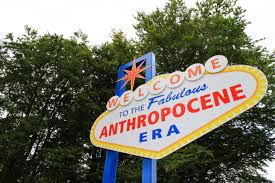
9 February 2016 – Last month in London I had the opportunity to attend a program at the Royal Society on the human imprint on the global environment, part of a series of programs over the last year running across several London museums and societies including the Science Museum, the Natural History Museum, the Royal Statistical Society and the British Library.
The programs include both man’s impact on the forces of Nature as well as the impact of the information-communication revolution on man itself.
Although global-scale human influence on the environment has been recognized since the 1800s, the term Anthropocene, introduced about a decade ago, has only recently become widely, but informally, used in the global change research community. However, the term has yet to be accepted formally as a new geological epoch or era in Earth history. Many in the Royal Society have put forward the case for formally recognizing the Anthropocene as a new epoch in Earth history, arguing that the advent of the Industrial Revolution around 1800 provides a logical start date for the new epoch.
Some thoughts … then the video
For hundreds of years before the arrival of Spanish conquistadors, American cultures like the Aztecs, Mayans, and Incas flourished. Millions of people lived in sprawling cities full of sophisticated culture and technology. Yet today, just centuries after the last of these empires disappeared, we’re left with just a few traces of their time on Earth. Wait a few centuries more, and even less will remain. How can so much rich history just vanish?
Mainly because, for many reasons, these cultures were built out of stone and cloth rather than metal and glass. Fast forward a hundred thousand years or even a few million, and it’s not unlikely that the nearly all of humanity’s pre-industrial history, from Egypt to China to Europe to the Americas, will be invisible to future geologists for the same reasons. Soft stuff, ground to dust, just another rock.
But it will be different for us. Thanks to modern technology, we are the richest, healthiest, most comfortable, most mobile, most well-fed, and perhaps one of the most deadly species to ever live on this planet. As a result, the past 150 years or so have also reshaped our planet in some extreme ways, leaving impacts so deep and so transformative that future geologists, were they to analyze the layers of Earth’s crust, would see the beginning of a new geological epoch right around the time that you and I are alive: The Anthropocene.
And climate change is only the tip of the iceberg. In a stunning presentation at the Natural History Museum last fall, we learned how, in addition to the carbon cycle, humans are (i) significantly altering several other biogeochemical, or element cycles, such as nitrogen, phosphorus and sulphur, that are fundamental to life on the Earth; (ii) strongly modifying the terrestrial water cycle by intercepting river flow from uplands to the sea and, through land-cover change, altering the water vapour flow from the land to the atmosphere; and (iii) likely driving the sixth major extinction event in Earth history. Taken together, these trends are strong evidence that humankind, our own species, has become so large and active that it now rivals some of the great forces of Nature in its impact on the functioning of the Earth system.
It is why the concept of the Anthropocene was introduced to capture this quantitative shift in the relationship between humans and the global environment. The term Anthropocene suggests: (i) that the Earth is now moving out of its current geological epoch, called the Holocene and (ii) that human activity is largely responsible for this exit from the Holocene, that is, that humankind has become a global geological force in its own right.
Over the past few years, scientists have been arguing whether the Anthropocene is a real thing, or how big of a mark it will leave on a future Earth. But new research, released last month, has taken stock of humanity’s 20th century impact and declared that the Anthropocene is definitely real, and it will be unmistakable to future geologists.
PBS has long brought us very original, thought-provoking programming. With PBS Digital Studios, they take that same mission and apply it to the Internet age. The following is by my Twitter and Tumblr buddy Joe Hanson who writes and produces the It’s Okay to be Smart series produced by PBS. In this installment he looks at the impact from plastic manufacturing and livestock breeding to chemical pollution and nuclear weapons, and attempts to draw a picture of what future explorers might see, what footprint we will leave for them, and what story they might tell of us. It was underwritten by my incredible web site design mates at SquareSpace.